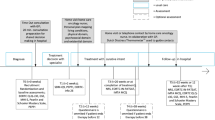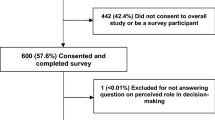Abstract
Background
Shared decision making and an integrative approach is expected to result in better outcomes, but might require more time. While ensuring that sufficient consultation time is essential to quality cancer care, it is not clear whether cancer patients feel that the amount of consultation time with their oncologists is sufficient.
Methods
Data were collected from 2,556 cancer patients on their perceived and preferred consultation time, and included potential predictors, such as socio-demographics, clinical, behavioral, and quality-of-life factors, as well as potential outcomes, including unmet patient needs, trust in doctor, and satisfaction. The feeling of insufficient consultation time was defined as the perception that consultation time is less than the preferred consultation time; multivariate analyses were used for identification of predictors and comparison of outcomes.
Results
Overall, 37.1% felt that consultation time was less than preferred. Younger age, female sex, higher education level, having national health insurance, having been diagnosed with less common cancers, and having anxiety/depression were significantly associated with feelings of insufficient consultation time. Subjects with a feeling of insufficient consultation time reported higher current needs for information, physical symptoms, and psychological problems. They also reported less trust in their physician, lower overall satisfaction, and lower intention to continue treatment at the current cancer center.
Conclusion
This study illustrated that high-quality cancer care, characterized by shared decision making and an integrative approach, seems to be related to sufficient consultation time that meets the individual’s subjective needs, and measures should be taken to ensure sufficient consultation time.
Similar content being viewed by others
References
Brown RF, Butow PN, Dunn SM, Tattersall MH (2001) Promoting patient participation and shortening cancer consultations: a randomised trial. Br J Cancer 85:1273–1279
Bruera E, Hui D (2010) Integrating supportive and palliative care in the trajectory of cancer: establishing goals and models of care. J Clin Oncol 28:4013–4017
Butow PN, Kazemi JN, Beeney LJ, Griffin AM, Dunn SM, Tattersall MH (1996) When the diagnosis is cancer: patient communication experiences and preferences. Cancer 77:2630–2637
Campbell JL, Ramsay J, Green J (2001) Practice size: impact on consultation length, workload, and patient assessment of care. Br J Gen Pract 51:644–650
Cape J (2002) Consultation length, patient-estimated consultation length, and satisfaction with the consultation. Br J Gen Pract 52:1004–1006
Cassileth BR, Zupkis RV, Sutton-Smith K, March V (1980) Information and participation preferences among cancer patients. Ann Intern Med 92:832–836
Choi KH, Park JH, Park SM (2010) Cancer patients' informational needs on health promotion and related factors: a multi-institutional, cross-sectional study in Korea. Support Care Cancer 19:1495–1504
Degner LF, Sloan JA (1992) Decision making during serious illness: what role do patients really want to play? J Clin Epidemiol 45:941–950
Detmar SB, Aaronson NK, Wever LD, Muller M, Schornagel JH (2000) How are you feeling? Who wants to know? Patients' and oncologists' preferences for discussing health-related quality-of-life issues. J Clin Oncol 18:3295–3301
Detmar SB, Muller MJ, Wever LD, Schornagel JH, Aaronson NK (2001) The patient–physician relationship. Patient–physician communication during outpatient palliative treatment visits: an observational study. JAMA 285:1351–1357
Deveugele M, Derese A, van den Brink-Muinen A, Bensing J, De Maeseneer J (2002) Consultation length in general practice: cross sectional study in six European countries. BMJ 325:472
Elwyn G, Edwards A, Kinnersley P (1999) Shared decision-making in primary care: the neglected second half of the consultation. Br J Gen Pract 49:477–482
Hack TF, Pickles T, Ruether JD, Weir L, Bultz BD, Degner LF (2009) Behind closed doors: systematic analysis of breast cancer consultation communication and predictors of satisfaction with communication. Psychooncology 19:626–636
Hall MA, Camacho F, Dugan E, Balkrishnan R (2002) Trust in the medical profession: conceptual and measurement issues. Heal Serv Res 37:1419–1439
Hall MA, Dugan E, Zheng B, Mishra AK (2001) Trust in physicians and medical institutions: what is it, can it be measured, and does it matter? Milbank Q 79:613–639, v
Howie JG, Porter AM, Forbes JF (1989) Quality and the use of time in general practice: widening the discussion. BMJ 298:1008–1010
Howie JG, Porter AM, Heaney DJ, Hopton JL (1991) Long to short consultation ratio: a proxy measure of quality of care for general practice. Br J Gen Pract 41:48–54
Hubbard G, Kidd L, Donaghy E (2008) Preferences for involvement in treatment decision making of patients with cancer: a review of the literature. Eur J Oncol Nurs 12:299–318
Hughes D (1983) Consultation length and outcome in two group general practices. J R Coll Gen Pract 33:143–147
Hull FM, Hull FS (1984) Time and the general practitioner: the patient's view. J R Coll Gen Pract 34:71–75
Hutton C, Gunn J (2007) Do longer consultations improve the management of psychological problems in general practice? A systematic literature review. BMC Heal Serv Res 7:71
Kim MH, Cho YS, Uhm WS, Kim S, Bae SC (2005) Cross-cultural adaptation and validation of the Korean version of the EQ-5D in patients with rheumatic diseases. Qual Life Res 14:1401–1406
Knight R (1987) The importance of list size and consultation length as factors in general practice. J R Coll Gen Pract 37:19–22
Lussier MT, Richard C (2007) Communication tips. Time flies: patients' perceptions of consultation length and actual duration. Can Fam Physician 53:46–47
Maguire P (1999) Improving communication with cancer patients. Eur J Cancer 35:1415–1422
Maguire P, Faulkner A, Booth K, Elliott C, Hillier V (1996) Helping cancer patients disclose their concerns. Eur J Cancer 32:78–81
Morrell DC, Evans ME, Morris RW, Roland MO (1986) The "five minute" consultation: effect of time constraint on clinical content and patient satisfaction. Br Med J (Clin Res Ed) 292:870–873
National Cancer Center (2009) Cancer facts and figures. National Cancer Center, Goyang, Korea
Ogden J, Bavalia K, Bull M, Frankum S, Goldie C, Gosslau M, Jones A, Kumar S, Vasant K (2004) "I want more time with my doctor": a quantitative study of time and the consultation. Fam Pract 21:479–483
Organization for Economic Co-operation and Development (OCED) (2009) OECD health data 2009. OECD, Paris
Petek Ster M, Svab I, Zivcec Kalan G (2008) Factors related to consultation time: experience in Slovenia. Scand J Prim Health Care 26:29–34
Pollak KI, Arnold RM, Jeffreys AS, Alexander SC, Olsen MK, Abernethy AP, Sugg Skinner C, Rodriguez KL, Tulsky JA (2007) Oncologist communication about emotion during visits with patients with advanced cancer. J Clin Oncol 25:5748–5752
Pollock K, Grime J (2002) Patients' perceptions of entitlement to time in general practice consultations for depression: qualitative study. BMJ 325:687
Robinson TM, Alexander SC, Hays M, Jeffreys AS, Olsen MK, Rodriguez KL, Pollak KI, Abernethy AP, Arnold R, Tulsky JA (2008) Patient–oncologist communication in advanced cancer: predictors of patient perception of prognosis. Support Care Cancer 16:1049–1057
Roland MO, Bartholomew J, Courtenay MJ, Morris RW, Morrell DC (1986) The "five minute" consultation: effect of time constraint on verbal communication. Br Med J (Clin Res Ed) 292:874–876
Shim EJ, Lee KS, Park JH, Park JH (2010) Comprehensive needs assessment tool in cancer (CNAT): the development and validation. Support Care Cancer (in press)
Siminoff LA, Ravdin P, Colabianchi N, Sturm CM (2000) Doctor–patient communication patterns in breast cancer adjuvant therapy discussions. Health Expect 3:26–36
Tulsky JA, Fischer GS, Rose MR, Arnold RM (1998) Opening the black box: how do physicians communicate about advance directives? Ann Intern Med 129:441–449
Walling A, Lorenz KA, Dy SM, Naeim A, Sanati H, Asch SM, Wenger NS (2008) Evidence-based recommendations for information and care planning in cancer care. J Clin Oncol 26:3896–3902
Westcott R (1977) The length of consultations in general practice. J R Coll Gen Pract 27:552
Whelan T, Sawka C, Levine M, Gafni A, Reyno L, Willan A, Julian J, Dent S, Abu-Zahra H, Chouinard E, Tozer R, Pritchard K, Bodendorfer I (2003) Helping patients make informed choices: a randomized trial of a decision aid for adjuvant chemotherapy in lymph node-negative breast cancer. J Natl Cancer Inst 95:581–587
Wilson A (1991) Consultation length in general practice: a review. Br J Gen Pract 41:119–122
Wilson AD (1985) Consultation length: general practitioners' attitudes and practices. Br Med J (Clin Res Ed) 290:1322–1324
Acknowledgments
This study has been supported by a grant from the National Cancer Center (Grant number; 0710170, 0910191), Republic of Korea. The authors would also like to thank the reviewers of this paper for their valid suggestions, which contributed to the improvement of the paper.
Financial disclosure/conflicts of interest
None.
Author information
Authors and Affiliations
Corresponding author
Additional information
This research was supported by a grant from the National Cancer Center of Korea.
Appendices
Appendix 1
Appendix 2
Rights and permissions
About this article
Cite this article
Shin, D.W., Park, JH., Shim, EJ. et al. Predictors and outcomes of feeling of insufficient consultation time in cancer care in Korea: results of a nationwide multicenter survey. Support Care Cancer 20, 1965–1973 (2012). https://doi.org/10.1007/s00520-011-1299-1
Received:
Accepted:
Published:
Issue Date:
DOI: https://doi.org/10.1007/s00520-011-1299-1




